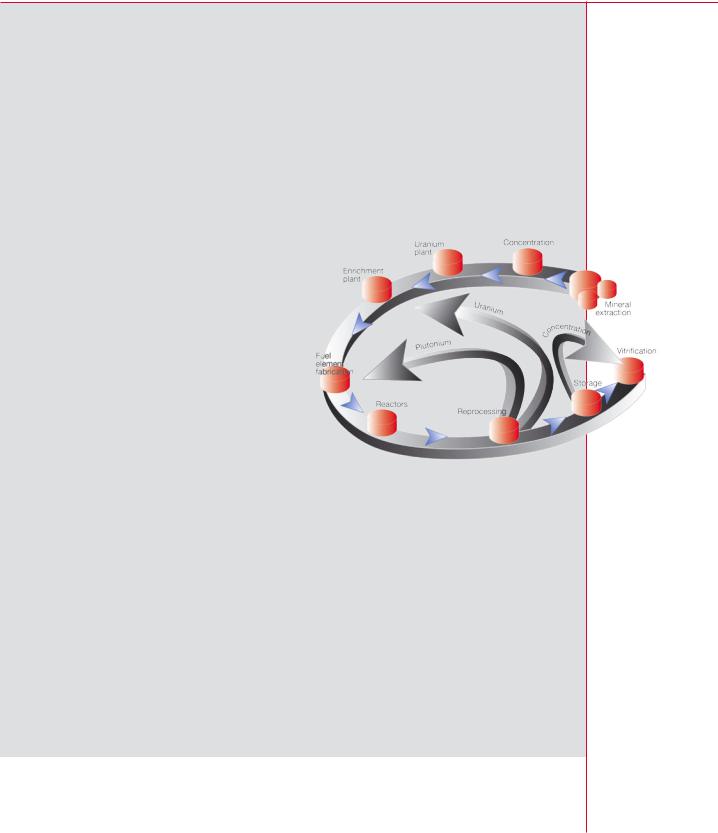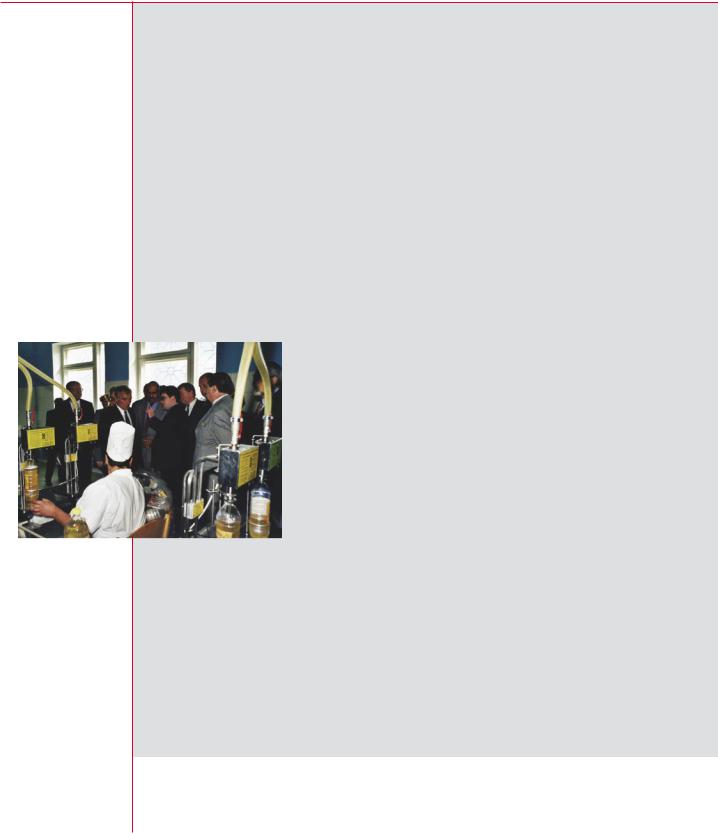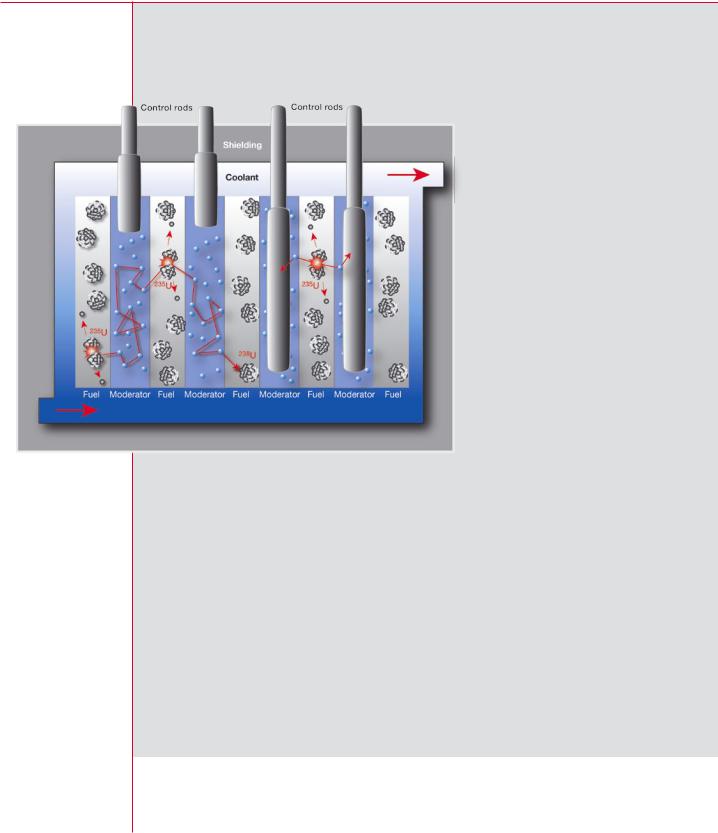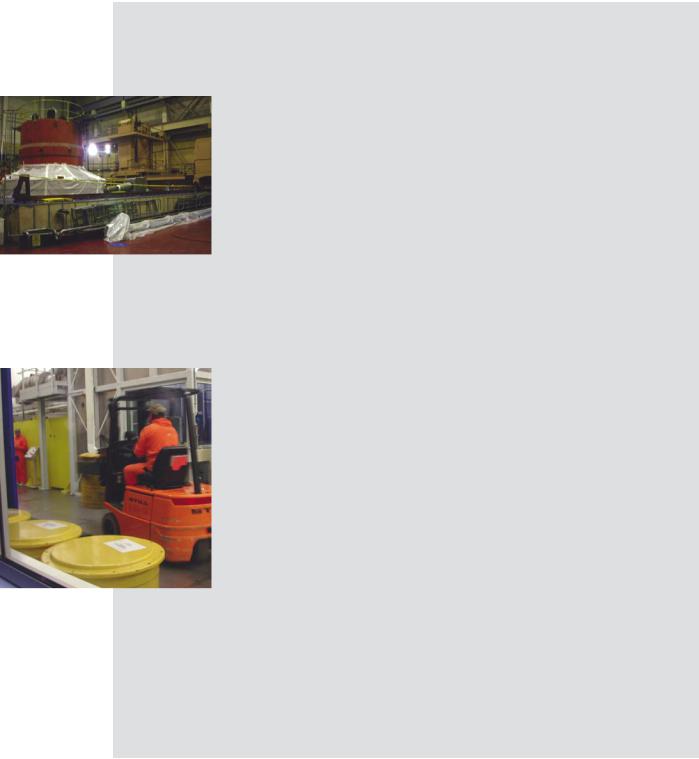
1radiation_people_and_the_environment
.pdf
Chapter 10 / Environmental pollution
Radioactive discharges
Radionuclides of artificial origin are discharged to the environment by the nuclear power industry, military establishments, research organizations, hospitals and general industry. Discharges of any significance should be subject to statutory control; they must be authorized and monitored. Owners or operators of the facilities from which radionuclides are discharged carry out monitoring programmes, as do some regulatory agencies.
The nuclear power industry discharges the most activity. At each stage of the nuclear fuel cycle, a variety of radionuclides are released in the form of liquids, gases, or solid particles. The nature of the effluent depends on the particular operation or process.
Each year, nuclear power reactors generate about 20 per cent of the world’s electrical energy.
During routine operation of nuclear installations, the releases of radionuclides are low and normally exposures have to be estimated with environmental transfer models. For all nuclear fuel cycle operations, including mining and milling, fuel fabrication, reactor operation and fuel reprocessing, the local and regional exposures are estimated by UNSCEAR to be about 0.9 man Sv per gigawatt-year (GW a). The present world nuclear energy generation is about 250 GW a annually, and so the total collec-
tive dose from a year’s generation of nuclear energy is about 200 man Sv. Generally individual
doses are low, being below 1 µSv in a year. However
certain individuals might receive higher doses because of where they live and what they eat and these should be subject to dose constraints, the maximum value being 300 µSv in a year.
In the case of accidents where there has been significant local contamination, the local doses can be significantly greater than the dose constraint. Where appropriate, measures are taken to minimize doses to people, such as the establishment of restricted areas in the vicinity of Chernobyl. Such measures can reduce both the individual and collective doses substantially.
Discharges from fuel reprocessing facilities give annual doses to the most exposed people — those who eat local seafood — up to 0.14 mSv mainly from actinides. Discharge to air of strontium-90 and other radionuclides leads to individual doses that are less than 0.05 mSv annually from the consumption of local milk and vegetables. The collective dose from airborne discharges, mainly due to carbon-14 in foodstuffs,
RADIATION, PEOPLE AND THE ENVIRONMENT
Diagram of nuclear fuel cycle showing fuel fabrication, reactor operation, fuel reprocessing, and waste management
47

Chapter 10 / Environmental pollution
Annual doses due to discharges from the nuclear fuel cycle
48
is approximately 500 man Sv annually. From liquid discharges, it is about 4000 man Sv annually mainly due to caesium-137 in fish.
|
|
Most exposed |
Collective |
Stage of cycle |
Type of effluent |
people |
dose |
|
|
(mSv) |
(man Sv) |
|
|
|
|
Fuel fabrication |
Airborne |
0.01 |
350 |
|
Liquid |
0.01 |
|
Reactor operation |
Airborne |
0.001 |
380 |
|
Liquid |
0.004 |
|
Fuel reprocessing |
Airborne |
0.05 |
4500 |
|
Liquid |
0.14 |
|
|
|
|
|
Although radioactive discharges to the environment are now strictly controlled in most countries, in the past they have not always been managed as they should have been. In particular, some military facilities operating during the Cold War adopted waste management methods that would be unacceptable for a modern civilian facility. As a result of the operation of one such example, the Mayak facility near Chelyabinsk in the Russian Federation, areas around the plant and downstream on the Techa River have very high levels of contamination, and some local people may have received very high doses (up to 1 sievert or more) over their lifetimes.
RADIATION, PEOPLE AND THE ENVIRONMENT

Chapter 10 / Environmental pollution
Depleted uranium
Munitions using depleted uranium (DU) were used during the Gulf War in 1991 and in the conflicts during the 1990s surrounding the break-up of Yugoslavia. The risks of harm to military personnel on a battlefield should be put in context of the other selfevident risks, but the use of depleted uranium ordnance has raised concerns about subsequent health consequences, both to service personnel and to the public after the conflict.
As has already been discussed, uranium occurs naturally in the environment. It is widely dispersed in the Earth’s crust, and in fresh water and sea water. As a result, we are all exposed to uranium isotopes and their decay products, and there are wide variations in doses received depending on local circumstances. DU is a by-product of the uranium fuel cycle where natural uranium is enriched to provide suitable fuel for nuclear power. It is called depleted because it has had some of its uranium-235 isotope removed. A large fraction of decay products of the uranium isotopes is removed during the fuel enrichment process.
Depleted uranium in munitions is in a concentrated metallic form, and there are understandable concerns about elevated levels in the environment due to spent munitions. There are also worries about people handling intact depleted uranium metal. Assessments of dose to military personnel who entered a tank shortly after it was hit by a DU weapon indicate possible doses of up to a few tens of mSv from inhalation of vapours and dust. In contrast, doses to people exposed some time afterwards to resuspended dust in the same local environment are likely to be a thousand times less, typically a few tens of µSv. Contact doses when handling bare DU metal are approximately 2.5 mSv/h, primarily from beta radiation, which is not penetrating and so affects only the skin. Even so, the collection of bare DU munitions needs to be discouraged and, if possible, avoided completely.
Doses from depleted uranium are, therefore, real and, in some circumstances, they could be appreciable for military personnel. Doses to people in the post-conflict phase are likely to be much lower and should be relatively easy to avoid.
Managing contaminated areas
As we have seen (and will see from other examples in later chapters), areas in various parts of the world have become contaminated with radionuclides as a result of various human activities. In cases where the level of contamination is high, measures might be needed to ensure that the area is safe for people to live or use for other purposes. For small areas, it might be possible to do this by removing contaminated soil and other materials, but for large areas the amount of material would be too large.
RADIATION, PEOPLE AND THE ENVIRONMENT
Pasture land nearby
Semipalatinsk test site in Kazakhstan
49

Chapter 10 / Environmental pollution
Other ways of protecting people include restrictions on access to or use of areas, for example, preventing house building on areas affected by mining wastes that could produce high radon levels. Chemical treatments can also be used to reduce the amount of activity that gets from soil into food. Examples of this include giving ‘Prussian blue’ — a chemical that increases the rate at which caesium is excreted by the cow so that it does not get into milk and meat — to cows grazing on contaminated grass in the Chernobyl area and treating the soil on Bikini Island with potassium to stop the trees absorbing caesium.
Total doses
With the exception of some military facilities and those mentioned above, no other facilities that discharge artificial radionuclides to the environment cause doses much above 0.02 mSv in a year to the most exposed people; nor do they make a significant contribution to collective dose. On average, therefore, the maximum effective dose from the discharge of artificial radionuclides, other than some military facilities, is about 0.14 mSv in a year and the collective effective dose about 5000 man Sv in a year or 0.001 mSv when averaged throughout the entire global population.
Extracting oil from rapeseed provides new productive uses for land in Belarus contaminated by the Chernobyl accident V. Mouchkin/IAEA
50 RADIATION, PEOPLE AND THE ENVIRONMENT

Chapter 11 / Nuclear power
Chapter 11 Nuclear power |
|
Nuclear reactors have been producing electricity since the 1950s and, in early 2003, |
|
there were 441 nuclear reactors operating in 30 countries with a total installed capacity |
|
of 359 GW. |
|
Nuclear reactors |
|
Nuclear reactors depend on a reaction between neutrons and the atomic nuclei of |
|
the fuel for their operation. Uranium, the fuel for almost all reactors, consists princi- |
|
pally of two isotopes, uranium-235 and uranium-238. In natural uranium, the fuel for |
|
early reactors, those isotopes are in the proportion of 0.7 per cent and 99.3 per cent, |
|
respectively, by weight. The enriched uranium used in most currently operating reactors |
|
contains about 2.5 per cent of uranium-235. |
|
Energy is released when a uranium-235 nucleus absorbs a neutron and undergoes |
|
fission, that is, it splits into two large energetic fragments or fission products, accom- |
|
panied by the release of several high energy or fast neutrons and some gamma radia- |
|
tion. The neutrons are slowed in the reactor so that they induce further fissions in the |
|
uranium-235. Such neutrons are often called thermal neutrons and the reactors that |
Schematic diagram |
rely upon them thermal reactors. By contrast, when a nucleus of uranium-238 absorbs |
of uranium-235 |
a fast neutron, it becomes uranium-239, which ultimately decays to form plutonium-239. |
fission |
This will also fission or capture neutrons to form |
|
isotopes of additional actinides, such as americium |
|
or curium. Consideration is currently being given to |
|
fuelling some reactors with mixed oxide fuel (known |
|
as MOX), which contains enriched uranium mixed with |
|
plutonium recovered from spent fuel by reprocessing. |
|
This is seen as a way of recycling fuel and control- |
|
ling stockpiles of plutonium that can be used to make |
|
nuclear weapons. |
|
The fuel in a nuclear reactor is assembled in an array |
|
called the core, which also contains the moderator, |
|
a material, generally water or graphite, that slows or |
|
thermalizes the neutrons. A coolant, usually water or |
|
gas, conducts heat away from the fuel and then passes through heat exchangers to |
|
make steam. The steam then drives turbine generators to make electricity. |
|
RADIATION, PEOPLE AND THE ENVIRONMENT |
51 |
|
|

Chapter 11 / Nuclear power
The fuel is sealed in metal containers, and the core is contained in a pressure vessel (or, in some designs, fuel elements are contained in separate pressure tubes). Massive concrete shielding helps to absorb the intense radiation emitted by the core during and after operation. Most reactors also have an additional containment building surrounding the reactors and usually the heat exchangers.
Fresh fuel is only mildly radioactive and can be handled without shielding. Once in the reactor, however, there is an enormous increase of activity due mainly to the fission products that have been generated in the fuel; this means that an accident at the reactor could release significant amounts of radioactive material. After removal from the reactor, the spent fuel remains hot and must be cooled to prevent melting, as well as shielded to reduce radiation exposure.
Although safety is a crucial issue for all nuclear power plants, there has been a particular focus since the Chernobyl accident and the breakup of the USSR on the safety of WWER and RBMK reactors. Thanks to the efforts of
Schematic diagram specialists in eastern Europe and the former Soviet Union supported by many inter- of nuclear reactor national co-operation projects, great progress has been made in upgrading the safety
of these reactors.
The main types of reactor are: |
hydrogen atoms have been replaced with |
|
deuterium, an isotope of hydrogen) as a |
Pressurized water reactors (PWRs), |
moderator and coolant; |
boiling water reactors (BWRs) and WWER |
|
reactors (a Soviet reactor design similar |
Gas cooled reactors, which use carbon |
to a PWR), all of which use water as |
dioxide gas as a coolant and usually |
moderator and coolant; |
graphite as moderator; and |
Heavy water reactors such as the |
Water-cooled graphite-moderated reactors |
Canadian-designed CANDU reactors, |
of the RBMK design developed originally |
which use heavy water (water in which the |
in the USSR. |
52 RADIATION, PEOPLE AND THE ENVIRONMENT |
|

Chapter 12 / Waste management
Chapter 12 Waste management
In Chapter 10 we described the discharge of effluents from the nuclear fuel cycle, but there are also other radioactive wastes. These come not only from the various parts of the nuclear fuel cycle — from the mining and processing of uranium to the dismantling of old nuclear installations — but also from medical, industrial and research activities involving radioactive materials.
Exempt waste contains such a low con- |
in the mining and processing of uranium |
Different countries |
||
centration of activity that it does not need |
and other minerals, such as phosphates |
classify wastes |
||
to be treated differently from ordinary |
used in fertilizers; |
in different ways, |
||
non-radioactive waste; |
|
|
|
but a number of |
|
Alpha |
waste |
(or transuranic waste) |
general categories |
Low/intermediate level waste consists of |
— waste containing alpha emitting |
can be identified |
||
items such as paper, clothing and labora- |
radionuclides such as isotopes of pluto- |
|
||
tory equipment that have been used in |
nium — is treated as a separate category |
|
||
areas where radioactive substances are |
in some countries; and |
|
||
handled, as well as contaminated soil |
|
|
|
NORM waste is |
and building materials, along with more |
High level waste refers only to spent fuel |
produced in |
||
active materials used in the treatment of |
from a reactor (in countries where this |
mining and |
||
gaseous and liquid effluents before they |
is regarded as a waste) or to the highly |
fertilizer processing |
||
are discharged to the environment, or the |
active liquid produced when |
|
||
sludges that accumulate in the cooling |
spent |
fuel is |
reprocessed. |
|
ponds where spent fuel is stored; |
The volume of this type of |
|
||
|
waste is very low, but its |
|
||
Short lived waste contains mainly |
activity is so high that it |
|
||
radionuclides with relatively short half- |
generates considerable heat. |
|
||
lives (less than 30 years), with only |
|
|
|
|
very low concentrations of long lived |
|
|
|
|
radionuclides; |
|
|
|
|
NORM (naturally occurring radioactive |
|
|
|
|
material) waste consists of often very |
|
|
|
|
large amounts of waste containing fairly |
|
|
|
|
low concentrations of naturally occurring |
|
|
|
|
radionuclides (though these concentra- |
|
|
|
|
tions are often higher than those found in |
|
|
|
|
nature). This type of waste is generated |
|
|
|
|
|
RADIATION, PEOPLE AND THE ENVIRONMENT |
53 |
||

Chapter 12 / Waste management
Type of |
Typical sources |
Characteristics |
Disposal |
|
waste |
||||
|
|
|
||
|
|
|
|
|
Exempt |
Contains very |
Can be treated |
Normal municipal |
|
waste |
limited amounts of |
as normal refuse |
refuse disposal facilities |
|
|
radionuclides |
|
|
|
Mining |
Mine tailings |
Huge volumes |
Mine tailings dams |
|
waste |
|
|
— return high grade |
|
|
|
|
tailings underground |
|
NORM |
Waste from minerals |
Enhanced levels |
Mine tailings for low |
|
waste |
processing scale from |
of naturally |
grades, on surface |
|
|
pipes or equipment |
occurring |
storage for higher |
|
|
|
radionuclides |
grades |
Low/ |
Contaminated |
intermediate |
paper, clothing, |
level waste |
laboratory equipment, |
|
contaminated soil and |
|
building materials |
|
Ion exchange materials |
|
from treatment of |
|
effluents sludges from |
|
cooling ponds |
Alpha |
As low/intermediate |
waste |
level waste, but with |
|
alpha (especially |
|
plutonium) |
|
contamination |
High level |
Spent fuel (when |
waste |
treated as waste) |
|
Highly active liquor |
|
from reprocessing |
Limited heat |
Shorter lived in near |
generation |
surface disposal |
|
facilities or intermediate |
|
depth mined caverns |
|
(from around 60 to |
|
100 m depth) |
|
Longer lived stored |
|
pending development |
|
of deeper disposal |
|
facilities |
Treated as a |
Geological disposal, |
special category |
consideration being |
in some |
given to intermediate |
countries |
depth storage (tens of |
|
metres) |
Need heavy |
Geological disposal |
shielding and |
(a few hundred metres |
cooling |
deep in stable |
|
geological formations) |
54 RADIATION, PEOPLE AND THE ENVIRONMENT

Chapter 12 / Waste management
The aims of waste management are to process the wastes in such a way as to make them suitable for storage and disposal, and to store or dispose of them so that there are no unacceptable risks to present and future generations. Here disposal implies simply that there is no intention to retrieve them, rather than that it would be impossible to do so.
In many countries, short lived waste is disposed of in near surface repositories, which are normally either lined trenches several metres deep or concrete ‘vaults’ constructed on or just below the ground surface. The disposed waste is covered with a few metres of earth, and often a clay cap to keep water out. A similar disposal method is used in some countries for the disposal of large amounts of NORM waste, such as tailings from the mining and milling of uranium. For example, Sweden operates a repository under the bed of the Baltic Sea at Forsmark for its more active (but mostly short lived) low/intermediate level waste.
Many low/intermediate level wastes do not occur in a form that is immediately suitable for disposal; they have to be mixed into an inert material such as concrete, bitumen or resin. In the past, some countries disposed of these wastes into the ocean, but since that has been prohibited by the London Convention, these wastes are normally stored awaiting decisions on the method of disposal. Among the most likely options is a repository deep underground in good geological conditions. Although many countries have plans for geological repositories of this type, only the USA is currently operating one, the Waste Isolation Pilot Plant (WIPP) in New Mexico, for wastes containing actinides.
Where the intention is to dispose of spent nuclear fuel directly
rather than reprocess it, the spent fuel is stored, either at reactor sites or in special central facilities. This is partly to allow the fuel to cool, but clearly it must continue until a disposal facility is available. High level liquid waste from reprocessing operations is normally kept in special cooled tanks, but facilities to solidify it by incorporation in vitreous material are being built. The glass blocks will be stored for several decades to allow them to cool before eventual disposal, probably deep underground.
Decommissioning
Decommissioning is the process that takes place at the end of the working life of a nuclear facility (or part of a facility), or any other place where radioactive materials were used, to bring about a safe long term solution. This might include decontaminating equipment or buildings, dismantling facilities or structures, and removing or immobilizing remaining radioactive materials. In many cases, the ultimate objective is to clear the site of all significant radioactive residues, but this is not always possible or necessary.
RADIATION, PEOPLE AND THE ENVIRONMENT
Underground repository in Sweden
Vitrified high level radioactive waste
55

|
Chapter 12 / Waste management |
|
|
The Greifswald |
To date, relatively few full scale commercial nuclear facilities have been completely |
and Rheinsberg |
decommissioned. However a great deal of experience has been gained from the |
decommissioning |
decommissioning of a wide variety of facilities, including a few nuclear power plants, |
project in Germany |
several prototype and research reactors, and many laboratories, workshops, etc. |
J. Ford/IAEA |
The fact that many nuclear reactors around the world are approaching the end |
|
of useful life has focused attention on the issues associated with |
|
decommissioning. |
|
Decommissioning requires strict control of operations to optimize |
|
the protection of workers and the public. For dealing with the most |
|
radioactive parts of a facilities, particularly reactor cores, remote |
|
handling techniques have been developed. Dismantling of large |
|
facilities also generates large volumes of ‘waste’. Some of this will be |
|
low/intermediate level radioactive waste and needs to be managed |
|
accordingly. However, there may also be large amounts of structural |
|
materials — such as steel and concrete — that are not significantly |
After removal of |
radioactive. Special procedures may be needed to ‘clear’ such materials as exempt, |
nuclear fuel, |
meaning that they do not have to be treated as radioactive waste. |
reactor vessel |
|
is shielded for |
Disposal criteria |
decommissioning |
|
work |
|
|
There has been considerable discussion of the criteria to be used |
|
in judging the acceptability of waste disposal methods both from |
|
a radiological protection point of view and from the wider social |
|
perspective. The consensus would seem to be that people in future |
|
generations should be protected to the same degree as they would |
|
be at present. However, it is difficult to translate this requirement |
|
into practical standards of radiological protection. For example, |
|
activity may only emerge from a deep repository many thousands |
|
of years later, and we have no idea what the habits or ways of life of |
|
our descendants will be so far into the future. |
|
A second requirement is to apply the principle that all exposures |
|
should be as low as reasonably achievable once economic and |
|
social factors have been taken into account. This means that the |
|
various options for managing a particular type of waste — including |
Negatively |
treatment, immobilization, packaging and disposal — should be compared on the |
pressurized |
basis of the associated risks, costs and other less quantifiable, but no less important |
compaction room, |
factors. Some of this comparison will be within the scope of radiological protection, |
where dismantled |
but other influences could determine the eventual decision. |
pieces are |
|
compacted and |
The difficult question for society about waste disposal is what weight to give now |
placed in |
to a mathematical probability of harmful effects in the distant future. This problem is |
specialized |
not unique to waste disposal nor to radiological protection, although it is particularly |
containers |
pointed here. The most ethical answer may be to assume that present conditions |
56 |
RADIATION, PEOPLE AND THE ENVIRONMENT |
|
|
